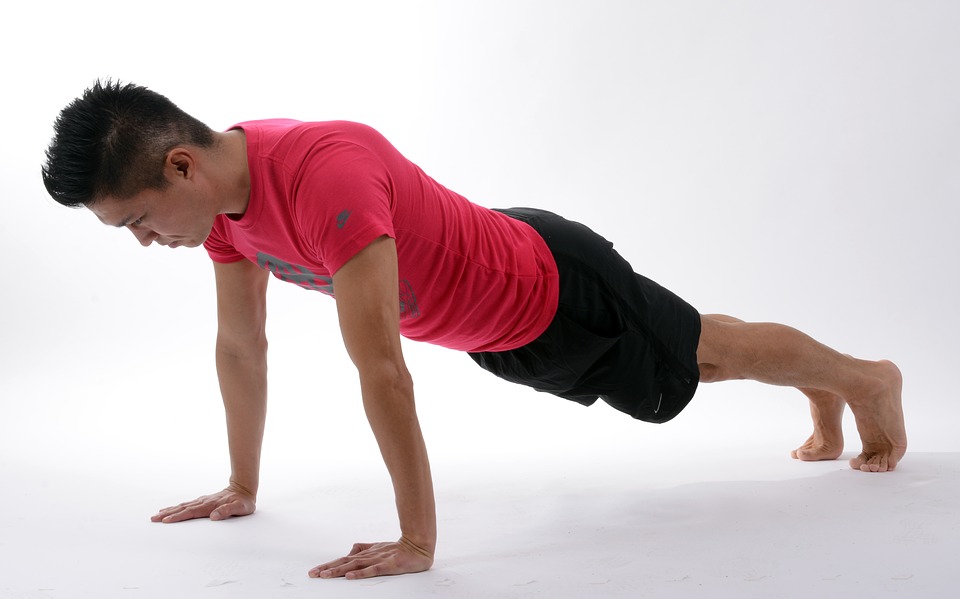Everybody should be able to do fifty pushups. There, I said it. Regardless of your individual goals, whether they be competing in a strongman contest or finishing first in your age group for a marathon, you should have an athleticism that allows you to do fifty pushups.
Notice I used the word “athleticism.” Because that’s what high-repetition pushups require. People have been brainwashed into thinking that high-repetition sets of any exercise develop endurance and only endurance. But high-rep pushups also build strength, power, and muscularity.
If you’re skeptical, consider this. It’s been established in the exercise science community that a typical 800m runner’s body is split almost equally between fast and slow twitch fibers–52% fast twitch, and 48% slow twitch (Essentials of Strength Training and Conditioning, Baechle et al, pg 66). Now, even though genetics and not training determines your own personal proportion of fiber types, we can still glean something useful from this. If a typical 800m runner has a particular proportion of muscle fiber types, and that proportion sets him apart from athletes in other sports, then that proportion is the very thing that makes him successful at the 800m run. In simpler terms, successful 800m running requires an equal mix of fast and slow twitch muscle fibers.
If we used exercise terminology and applied it to the 800m run, then a “set” would last anywhere from 1:41 to 2 minutes, and it would consist of several hundred “reps.”
With this in mind, we can see clearly that a set of fifty pushups, which should take no more than a minute to complete, would not be a pure endurance exercise and instead would be very taxing to fast-twitch muscle fibers–the very fibers responsible for strength, power and muscularity.
How to Get There
All that’s fine and dandy, but how do you do it? If you’re stuck at ten, or even one, how do you build up to fifty pushups?
Try these three tips:
1. Increase the Volume
If you’re struggling to get to fifty, the first step is to actually do fifty pushups.
Start out by setting a rep target appropriate to your current abilities. If you can only do one pushup before crapping out, set a target of five to ten. If you can do ten, set your target to fifty to one hundred.
Then do your target repetitions, spreading the work out in as many sets as you need. Back in high school, after wrestling practice, I did 100 pushups a night while watching TV–10 sets of 10 done on commercial breaks.
As you get better, increase your rep target.
2. Go Over, Then Go Under
In keeping with the running analogy, a common track workout for runners of all distances is the “over-under.” The concept is simple: Practice running at distances shorter and farther than race distance. In theory, the shorter distances build a little more strength and power, and the longer distances build a little more endurance.
To apply this same theory to pushups, do sets for strength and sets for endurance. Try this:
- Unders – Elevate your feet on a knee-high bench and perform pushups. The body position here puts more stress on your upper body and makes the resistance heavier. Do sets with half the reps you’re able to use on regular pushups (i.e., if you can do sets of 20 with regular pushups, do sets of 10 with feet-elevated pushups).
- Overs – Do pushups on your knees, keeping your body alignment stiff and straight. Do sets with 50% more reps than your able to use on regular pushups (i.e., if you do sets of 20 with regular pushups, do 30 with pushups on your knees). If pushups on your knees hurt, try pushups with your hands on a wall or a high table instead.
3. Go Faster
Rep tempo is up to you, but I suggest that you try and complete your set as fast as you can while maintaining good form. Most trainers suggest you go at a moderate pace, but I don’t buy that. There are usually two reasons trainers suggest going slowly. First is safety. Going slowly reduces the chance for muscle pulls and strains. That’s a valid point, and if you don’t have the strength to do 20 pushups in decent form, then you shouldn’t be worrying about speed. But the second reason is that they believe going slower makes the exercise easier.
In one sense, they’re absolutely right. A set of twenty pushups in twenty seconds requires twice as much force as twenty pushups in forty seconds, because an equal amount of work is being performed in half the time.
But for most people, strength is not the limiting factor in pushups. Endurance is. If you have the strength to do twenty pushups, then you have the strength to do fifty. Performing your pushups at a slower tempo lengthens the duration of the set and the amount of time your working muscles are under tension. Reaching fifty pushups then becomes more about resisting fatigue than about using the strength of your muscles.
If you do your pushups at a faster tempo, you’ll be able to bypass more of the accumulative fatigue and burn, and you’ll be limited more so by your strength. As you get stronger from training, you’ll reach fifty in no time.
Ron Gullekson is a certified personal trainer in Orlando, Florida, with several years of experience as a physical training instructor in the US Navy. He now specializes in providing innovative fitness solutions to the civilian population. See more at http://www.gritphysicaltraining.com
Want to reach your fitness goals?
Level up your fitness journey with our free online journal! Track cardio, strength training, and flexibility. Set goals, visualise progress, stay motivated. Personalise, analyse, and connect with a supportive community. Elevate your workouts, achieve results!
Sign up now
